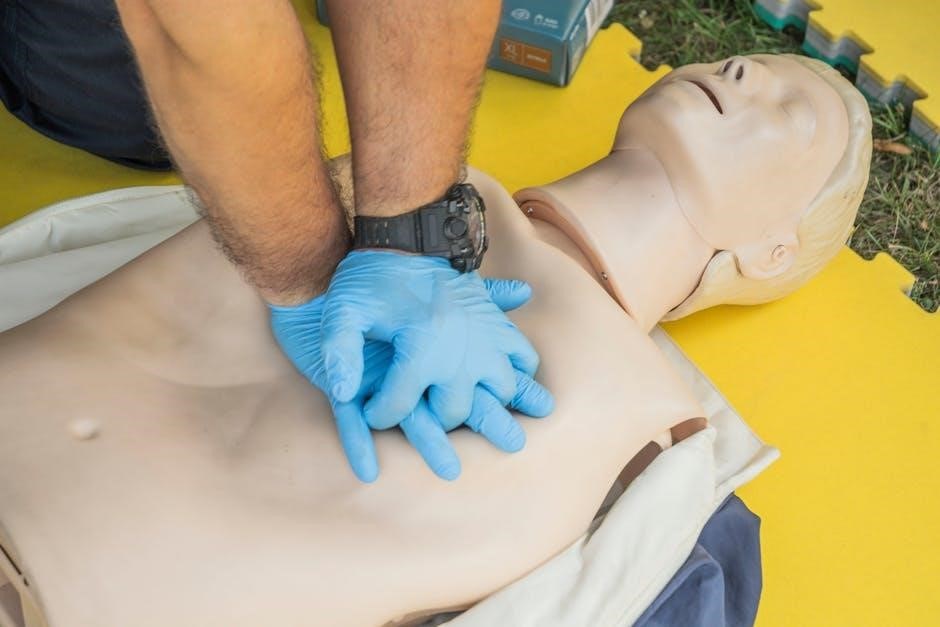Manual handling training is essential for healthcare workers to ensure safe patient care, prevent injuries, and comply with legal standards. It teaches techniques to minimize risks and promote best practices.

1.1 Importance of Manual Handling in Healthcare
Manual handling is critical in healthcare as it directly impacts patient safety and staff well-being. Healthcare workers frequently lift, move, and support patients, making proper techniques essential to prevent injuries. Poor manual handling can lead to musculoskeletal disorders, work-related injuries, and reduced patient care quality. Effective training ensures staff can perform tasks safely, minimizing risks for both themselves and patients. Additionally, proper manual handling reduces the likelihood of patient falls, injuries, or discomfort during transfers. It also fosters a safer workplace culture, promoting efficiency and reducing absenteeism due to injuries. Legal standards further emphasize the importance of adhering to safe practices, making manual handling training a cornerstone of healthcare education and operations. By prioritizing safe manual handling, healthcare facilities can enhance patient outcomes and protect their workforce.
1.2 Defining Manual Handling and Its Legal Definitions
Manual handling refers to the use of bodily force to lift, lower, push, pull, carry, or move loads. In healthcare, this often involves patient transfers or equipment movement. Legally, manual handling is governed by regulations such as the Manual Handling Operations Regulations, which aim to minimize risks of injury. These laws require employers to assess tasks, reduce manual handling where possible, and provide training. Workers must understand their legal obligations to perform tasks safely. Breaches can result in legal consequences for both employers and employees. Compliance ensures a safer environment for patients and staff.

Why Manual Handling Training is Necessary
Manual handling training reduces workplace injuries, promotes safety, and ensures efficiency in patient care. It equips healthcare workers with essential skills to handle tasks safely, adhering to legal and safety protocols while safeguarding patient and staff well-being.

2.1 Risks Associated with Poor Manual Handling
Poor manual handling practices pose significant risks, including musculoskeletal injuries, back strains, and long-term health issues for healthcare workers. These injuries can result from improper lifting, repetitive tasks, or excessive force, leading to absenteeism and reduced productivity. Additionally, patients may suffer harm if manual handling is not performed safely, compromising care quality. The financial burden on healthcare facilities increases due to workers’ compensation claims and medical costs. Furthermore, non-compliance with safety standards can lead to legal consequences and reputational damage. Addressing these risks through proper training is crucial to safeguarding both staff and patients. Effective manual handling techniques mitigate these dangers, ensuring a safer workplace and higher standards of patient care. Recognizing these risks underscores the importance of prioritizing safe practices in healthcare settings to prevent adverse outcomes and maintain operational efficiency.
2.2 Role of Training in Preventing Injuries
Manual handling training plays a critical role in preventing injuries by equipping healthcare workers with the knowledge and skills to perform tasks safely. Through structured programs, employees learn proper lifting techniques, body mechanics, and how to assess risks before engaging in manual tasks. Training emphasizes the importance of using assistive devices and team lifting when appropriate. It also fosters awareness of personal limitations and the need to adapt practices to individual capabilities. By teaching workers to recognize and avoid hazardous situations, training significantly reduces the likelihood of musculoskeletal injuries. Moreover, it empowers staff to take proactive steps in safeguarding both themselves and their patients, ultimately creating a safer and more efficient healthcare environment. Regular updates to training ensure that employees remain informed about best practices and new regulations, further enhancing injury prevention efforts.
2.3 Legal Compliance and Regulations
Legal compliance and regulations are fundamental to manual handling training in healthcare. Employers are legally obligated to ensure workers are trained to handle manual tasks safely, as outlined in the Manual Handling Operations Regulations 1992. These regulations require employers to assess manual handling risks, reduce them where possible, and provide training to employees. Healthcare facilities must adhere to these standards to avoid legal penalties and ensure a safe working environment. Training programs must align with regulatory guidelines, emphasizing risk assessments, proper techniques, and the use of assistive equipment. Compliance not only protects employees from injuries but also safeguards patients from potential harm. By adhering to legal standards, healthcare organizations demonstrate their commitment to workplace safety and accountability, ultimately fostering a culture of compliance and responsibility. Regular audits and updates to training programs ensure ongoing adherence to legal requirements and evolving industry standards.

Key Principles of Safe Manual Handling
Safe manual handling involves understanding body mechanics, assessing loads, using proper lifting techniques, and maintaining correct posture to minimize injury risks and ensure efficient patient care.
3.1 Understanding Body Mechanics
Understanding body mechanics is fundamental to safe manual handling. It involves knowing how your body moves and how forces act on it during tasks like lifting or moving patients. Proper alignment and balance are crucial to distributing weight evenly and minimizing strain on muscles and joints. A stable base of support, such as standing with feet shoulder-width apart, enhances control and reduces the risk of injury. Bending at the knees rather than the waist is essential to avoid back strain, as it engages stronger leg muscles. Additionally, maintaining a neutral spine during movements helps protect the back from excessive stress. Healthcare workers should also be aware of their posture and avoid twisting, which can lead to injuries. By applying these principles, workers can reduce the risk of harm to both themselves and their patients, ensuring safer and more efficient patient handling.
3.2 Assessing the Load
Assessing the load is a critical step in manual handling to ensure safety and efficiency. Healthcare workers must evaluate the weight, size, and balance of the load to determine the best approach for moving it. Understanding the load’s characteristics helps identify potential risks and informs the choice of handling techniques. For example, an unevenly distributed load may require additional support or assistance. The assessment also considers the distance the load needs to be moved and any obstacles in the path. By carefully evaluating the load, workers can plan their movements to minimize strain and prevent injuries. This step is essential for protecting both the worker and the patient, ensuring that the task is performed safely and effectively. Proper load assessment is a cornerstone of effective manual handling practices in healthcare settings. It promotes a proactive approach to handling tasks, reducing the likelihood of accidents and enhancing overall safety.
3.3 Proper Lifting Techniques
Proper lifting techniques are fundamental to safe manual handling in healthcare. Workers should bend at the knees, keeping the back straight, and lift using leg muscles rather than the back. The load should be held close to the body to maintain balance and control. Avoid twisting while lifting, as this can cause strain. Instead, pivot on the feet to change direction. It’s crucial to ensure a firm grip on the load and to lift smoothly, avoiding jerky movements. These techniques help reduce the risk of injury to both the worker and the patient. By following proper lifting methods, healthcare workers can perform their tasks more safely and effectively, minimizing the potential for harm. Proper lifting is a key component of manual handling training, ensuring that tasks are executed with precision and care. This approach fosters a safer working environment and better patient outcomes. The focus is on maintaining stability and control throughout the lifting process.
3.4 Importance of Posture
Proper posture is crucial in manual handling to reduce the risk of injury and enhance efficiency. Maintaining a neutral spine alignment ensures even distribution of force, minimizing strain on muscles and joints. Good posture helps prevent musculoskeletal disorders, which are common among healthcare workers due to repetitive tasks. When lifting or moving patients, keeping shoulders relaxed, core engaged, and body balanced reduces the likelihood of injury. Poor posture, such as slouching or twisting, can lead to unnecessary strain and increase the risk of harm to both workers and patients. Encouraging proper posture during training helps create a safer and more efficient working environment. By prioritizing posture, healthcare workers can perform their duties with greater comfort and effectiveness, ultimately improving patient care and safety. Proper posture is a foundational element of safe manual handling practices and should be consistently reinforced in training programs.

The Training Process
The training process is structured to equip healthcare workers with essential skills through risk assessments, practical exercises, and tailored methods, ensuring safe and effective patient handling.
4.1 Essential Components of a Training Program
A comprehensive manual handling training program for healthcare workers includes risk assessments, practical exercises, and demonstrations. It covers understanding body mechanics, load assessment, and proper lifting techniques. Training emphasizes posture, safe moving practices, and real-life scenario applications to ensure workplace safety and compliance with legal standards.

4.2 Conducting Risk Assessments
Conducting risk assessments is a critical step in manual handling training for healthcare workers. It involves identifying high-risk tasks, evaluating physical demands, and determining hazards associated with moving patients or equipment. Risk assessments help prioritize tasks, implement controls, and reduce injury risks. They ensure compliance with legal standards and guide training content. By evaluating tasks, healthcare facilities can minimize risks and create safer working environments.
4.3 Choosing the Right Training Methods
Choosing the right training methods is vital for effective manual handling training in healthcare. Methods should align with the specific needs of healthcare workers, ensuring practical and applicable skills. Techniques such as simulations, demonstrations, and hands-on exercises are highly effective. These methods allow workers to practice real-life scenarios, improving their ability to handle patients safely. Training should also incorporate visual aids and interactive elements to enhance engagement and retention. Additionally, the use of case studies and group discussions can foster problem-solving and teamwork. The goal is to provide a comprehensive learning experience that equips healthcare workers with the knowledge and confidence to perform manual handling tasks safely and efficiently. By selecting the most appropriate training methods, healthcare facilities can ensure their staff are well-prepared to meet the challenges of manual handling in a clinical setting.

Practical Exercises and Demonstrations
Practical exercises and demonstrations are crucial for reinforcing manual handling techniques. They provide healthcare workers with hands-on experience, enabling them to apply training in real-life patient care scenarios effectively.
5.1 Specific Exercises for Healthcare Workers
Specific exercises for healthcare workers focus on tasks common in clinical settings, such as patient transfers, lifting, and repositioning. These exercises emphasize proper body mechanics and techniques to minimize strain. Participants practice moving patients safely using sliding boards, hoists, or manual lifts when equipment is unavailable. Training also includes scenarios like assisting patients from beds to wheelchairs or bathrooms. These exercises are tailored to real-life challenges, ensuring workers can apply skills confidently. The focus is on maintaining patient dignity and safety while protecting the worker from injury. Practical demonstrations and hands-on practice are essential for mastering these skills. By simulating actual patient care situations, healthcare workers develop the competence and confidence to handle manual tasks effectively, reducing the risk of injury to both themselves and their patients.
5.2 Role of Demonstrations in Training
Demonstrations play a crucial role in manual handling training, as they provide healthcare workers with a clear visual understanding of proper techniques. By observing step-by-step procedures, participants can better grasp complex movements and safety protocols. Demonstrations allow trainers to highlight key principles, such as maintaining posture, using body mechanics, and minimizing strain. They also offer opportunities for workers to ask questions and receive immediate feedback, ensuring misunderstandings are addressed. Practical demonstrations often include both correct and incorrect methods, helping workers identify and avoid unsafe practices. This interactive approach enhances learning retention and reduces the likelihood of injuries. Demonstrations are particularly effective when paired with hands-on practice, as they bridge the gap between theory and application. They are essential for ensuring healthcare workers can confidently and safely perform manual handling tasks in real-life scenarios.
5.3 Applying Training in Real-Life Scenarios
Applying manual handling training in real-life scenarios is critical for healthcare workers to ensure patient safety and prevent injuries. Training programs often include simulations of common tasks, such as transferring patients or moving equipment, to help workers practice techniques in realistic settings. By replicating real-life challenges, workers can develop problem-solving skills and learn to adapt safe handling practices to diverse situations. Real-life applications also reinforce the importance of risk assessments and proper body mechanics. For example, understanding how to safely lift a patient from a bed or wheelchair is essential for minimizing strain and preventing accidents. Continuous feedback and refinement of techniques during these exercises help workers maintain high standards of care and safety. This practical application ensures that training translates into effective, injury-free practices in healthcare environments.

Benefits of Manual Handling Training
Manual handling training reduces work-related injuries, enhances patient care, and improves workplace safety culture. It also leads to cost savings for healthcare facilities by minimizing injury-related expenses and downtime.
6.1 Prevention of Work-Related Injuries
Manual handling training significantly reduces the risk of work-related injuries by teaching healthcare workers proper lifting techniques, body mechanics, and hazard assessment. By understanding how to safely handle patients and equipment, workers can minimize strain on muscles and joints; Training programs emphasize the importance of correct posture and balanced movements to avoid overexertion. Regular risk assessments further identify potential hazards, allowing for proactive measures to prevent accidents. Practical exercises and demonstrations ensure that workers apply these principles effectively in real-life scenarios. As a result, manual handling injuries, such as back strain and musculoskeletal disorders, are substantially reduced. This not only protects workers but also enhances overall workplace safety and patient care quality. Effective training leads to fewer injury-related absences, medical claims, and long-term health issues, creating a safer and more efficient healthcare environment.
6.2 Improving Patient Care and Safety
Manual handling training plays a crucial role in enhancing patient care and safety by ensuring that healthcare workers use proper techniques when moving or supporting patients. This reduces the risk of patient injuries, such as bruises, fractures, or dislocations, which can occur from improper handling. Proper lifting and transferring methods also minimize the risk of falls and accidents during patient transfers. By adhering to established guidelines and legal standards, healthcare workers can provide high-quality, safe care consistently. Training programs often include personalized assessments to determine the best handling methods for each patient based on their weight, medical condition, and specific needs. This tailored approach helps prevent complications like pressure sores or respiratory issues that may arise from incorrect positioning. Effective manual handling training fosters a safer and more respectful care environment, improving patient outcomes and satisfaction while maintaining their dignity.
6.3 Enhancing Workplace Safety Culture
Manual handling training significantly contributes to fostering a robust workplace safety culture in healthcare settings. By equipping staff with the knowledge and skills to handle patients safely, it promotes a proactive approach to preventing injuries and accidents. This training encourages healthcare workers to prioritize safety, leading to a reduction in workplace incidents and creating a safer environment for both employees and patients. A strong safety culture also enhances teamwork, as colleagues collaborate to ensure safe practices are consistently applied. Regular training updates and open discussions about safety further reinforce these values, making safety a shared responsibility. Over time, this cultural shift leads to fewer work-related injuries, improved staff morale, and a more resilient healthcare workforce. Ultimately, a safety-focused culture benefits the entire organization by reducing risks and fostering a commitment to excellence in patient care.
6.4 Cost Savings for Healthcare Facilities
Manual handling training offers significant cost savings for healthcare facilities by reducing work-related injuries and associated expenses. Fewer injuries mean lower medical treatment costs, workers’ compensation claims, and lost productivity. Additionally, training decreases absenteeism and the need for temporary staff, stabilizing workforce availability. Proper handling techniques also reduce equipment damage and extend the lifespan of medical tools, further cutting costs. By minimizing patient handling errors, facilities can avoid costly litigation and reputational damage. Investing in manual handling training is a proactive approach that yields long-term financial benefits while enhancing overall care quality and workplace safety. These savings contribute to a more sustainable and efficient healthcare system.

Addressing Common Challenges
Addressing challenges in manual handling training involves overcoming staff resistance, ensuring compliance, and maintaining training effectiveness. Tailoring programs to workplace needs fosters engagement and sustainable safety practices.
7.1 Overcoming Staff Resistance to Training
Overcoming staff resistance to manual handling training requires addressing perceptions and fostering engagement. Many healthcare workers may view training as unnecessary or time-consuming, especially if they feel experienced. To combat this, highlight the direct benefits, such as injury prevention and improved patient care. Involving staff in the planning process and tailoring content to real-life scenarios can increase relevance and acceptance. Offering incentives, like recognition or rewards for participation, can also motivate engagement. Additionally, demonstrating how proper techniques reduce physical strain and improve efficiency can help staff see the value. Leadership support is crucial, as visible endorsement from managers encourages participation. Lastly, emphasizing that training is a proactive measure to protect both workers and patients can shift perspectives and reduce resistance.
7.2 Ensuring Compliance with Training Requirements
Ensuring compliance with manual handling training requirements involves a structured approach to monitoring and reinforcing participation. Healthcare facilities must implement regular audits to track staff training completion and schedules for refresher courses. Clear communication of legal and organizational standards helps staff understand the necessity of adherence. Designating training coordinators to oversee compliance and provide reminders can enhance accountability. Additionally, incorporating training into performance reviews ensures it remains a priority; Providing accessible training materials and flexible scheduling accommodates different learning preferences and workloads. Recognizing and addressing barriers to participation, such as time constraints, can improve compliance rates. Finally, fostering a culture of safety and accountability encourages staff to prioritize training, ultimately benefiting both patient care and workplace safety.
7.3 Maintaining Training Effectiveness Over Time
Maintaining the effectiveness of manual handling training requires ongoing evaluation and updates to ensure it remains relevant and impactful. Regular refresher courses help reinforce previously learned techniques, preventing skill decay. Incorporating real-life scenarios and case studies allows healthcare workers to apply their knowledge practically. Feedback mechanisms enable trainers to identify gaps and adapt content accordingly. Utilizing a mix of training methods, such as hands-on demonstrations and interactive modules, caters to different learning styles and keeps the content engaging. Additionally, staying updated with the latest industry guidelines and research ensures the training aligns with current best practices. Continuous monitoring of workplace incidents related to manual handling helps identify areas for improvement, fostering a proactive approach to enhancing training effectiveness over time.
Manual handling training is vital for healthcare workers, fostering a safer environment and improving patient care while ensuring legal compliance and promoting long-term effectiveness.
8.1 Importance of Regular Training Updates
Regular updates to manual handling training are crucial to ensure healthcare workers stay informed about the latest techniques, equipment, and regulatory changes. These updates adapt to evolving workplace demands, new technologies, and emerging best practices. Continuous learning helps maintain competency and prevents complacency, which can lead to accidents. Updated training also addresses any gaps in knowledge or skills identified through incident reports or risk assessments. Additionally, it ensures compliance with changing legal requirements and industry standards. Regular refreshers reinforce safe practices, reducing the risk of injuries to both staff and patients. By keeping training current, healthcare facilities can sustain a culture of safety and excellence in patient care. Regular updates are essential for maintaining high standards and adapting to the dynamic nature of healthcare environments.
8.2 Impact of Effective Training on Healthcare Quality
Effective manual handling training significantly enhances healthcare quality by reducing work-related injuries and improving patient safety. Proper lifting and handling techniques minimize the risk of harm to both staff and patients, leading to better care outcomes. Safe practices reduce the likelihood of patient falls or injuries during transfers, fostering trust and satisfaction. Trained healthcare workers are more confident and competent, enabling them to deliver higher-quality care. Additionally, effective training promotes a culture of safety, encouraging staff to prioritize risk prevention. This, in turn, lowers the frequency of incidents and associated costs. By ensuring compliance with safety standards and regulations, effective training contributes to a safer, more efficient healthcare environment. Ultimately, it supports the overall mission of providing excellence in patient care while safeguarding healthcare workers.